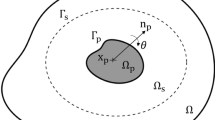Abstract
The cohesive crack model is a widely used idealization to represent simply and reliably the quasibrittle fracture behavior of concrete-like materials. However, knowledge of the parameters characterizing this model is of prime importance and cannot all be obtained directly from experiments. Typically, recourse is made to some inverse numerical approach. Our particular formulation can be elegantly cast as an instance of a challenging optimization problem known as a mathematical program with equilibrium (or, more precisely in our case, complementarity) constraints (MPEC). The present paper investigates application of an entropic optimization approach to solve the MPEC, and compares its performance with our previously proposed Fischer–Burmeister smoothing scheme. We use actual experimental data for the comparison.
Similar content being viewed by others
References
Barenblatt, G.I. 1962: The mathematical theory of equilibrium cracks in brittle fracture. Adv Appl Mech7, 55–129
Birbil, S.I.; Fang, S.-C.; Han, J. 2003: Entropic regularization approach for mathematical programs with equilibrium constraints. ERIM Research Report Series ERS-2002-71-LIS, Erasmus Research Institute for Management, Erasmus University, Rotterdam, The Netherlands
Bolzon, G.; Ghilotti, D.; Maier, G. 1997: Parameter identification of the cohesive crack model. In: Sol, H.; Oomens, C.W.J. (eds.) Material identification using mixed numerical and experimental methods, pp. 213–222, Dordrecht: Kluwer Academic
Bolzon, G.; Maier, G.; Novati, G. 1994: Some aspects of quasi-brittle fracture analysis as a linear complementarity problem. In: Bažant, Z.P.; Bittnar, Z.; Jirásek, M.; Mazars, J. (eds.) Fracture and damage in quasibrittle structures, pp. 159–174, London: E&FN Spon
Brooke, A.; Kendrick, D.; Meeraus, A.; Raman, R. 1998: GAMS: a user’s guide. Gams Development Corporation, Washington DC 20007
Carpinteri, A. 1989: Cusp catastrophe interpretation of fracture instability. J Mech Phys Solids37, 567–582
Denarié, E.; Saouma, V.E.; Iocco, A.; Varelas, D. 2001: Concrete fracture process zone characterization with fiber optics. J Eng Mech ASCE127, 494–502
Dirkse, S.P.; Ferris, M.C. 1995: The PATH solver: a non-monotone stabilization scheme for mixed complementarity problems. Optim Methods Softw5, 123–156
Dolan, E.D.; Fourer, R.; Moré, J.J.; Munson, T.S. 2002: Optimization on the NEOS server. SIAM News35, 8–9
Drud, A. 1994: CONOPT – a large-scale GRG code. ORSA J Comput6, 207–216
Dugdale, D.S. 1960: Yielding of steel sheets containing slits. J Mech Phys Solids8, 100–104
Facchinei, F.; Jiang, H.; Qi, L. 1999. A smoothing method for mathematical programs with equilibrium constraints. Math Program85, 107–134
Fang, S.C.; Rajasekera, J.R.; Tsao, H.S. 1997: Entropy optimization and mathematical programming. Norwell:Kluwer Academic
Hillerborg, A.; Modéer, M.; Petersson, P.E. 1976: Analysis of crack formation and crack growth in concrete by means of fracture mechanics and finite elements. Cement Concrete Res6, 773–782
Kanzow, C. 1996. Some noninterior continuation methods for linear complementarity problems. SIAM J Matrix Anal Appl17, 851–868
Luo, Z.Q.; Pang, J.S.; Ralph, D. 1996: Mathematical programs with equilibrium constraints. Cambridge: Cambridge University Press
Maier, G. 1981: Inverse problem in engineering plasticity: a quadratic programming approach. Academia Nazionale dei LinceiLXX (Serie VIII), 203–209
Olsen, D.H. 1998: Concrete fracture and crack growth: a fracture mechanics approach. Department of Structural Engineering and Materials. Report No. 42, Series R, Technical University of Denmark
Tin-Loi, F.; Li, H. 2000: Numerical simulations of quasibrittle fracture processes using the discrete cohesive crack model. Int J Mech Sci42, 367–379
Tin-Loi, F.; Que, N.S. 2001: Parameter identification of quasibrittle materials as a mathematical program with equilibrium constraints. Comput Methods Appl Mech Eng190, 5819–5836
Tin-Loi, F.; Que, N.S. 2002a: Nonlinear programming approaches for an inverse problem in quasibrittle fracture. Int J Mech Sci44, 843–858
Tin-Loi, F.; Que, N.S. 2002b: Identification of cohesive crack fracture parameters by evolutionary search. Comput Methods Appl Mech Eng191, 5741–5760
Tin-Loi, F.; Xia, S.H. 2001: Holonomic softening: models and analysis. Mech Struct Mach29, 65–84
Wittmann, F.H. (ed.) 1996: Fracture mechanics of concrete structures, Vol. III. Freiburg, Germany: AEDIFICATIO Publishers
Author information
Authors and Affiliations
Corresponding author
Rights and permissions
About this article
Cite this article
Tin-Loi, F. An entropic optimization approach for a parameter identification problem in quasibrittle fracture. Struct Multidisc Optim 28, 442–450 (2004). https://doi.org/10.1007/s00158-004-0453-5
Received:
Published:
Issue Date:
DOI: https://doi.org/10.1007/s00158-004-0453-5




